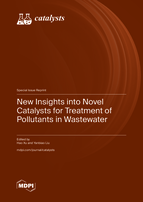New Insights into Novel Catalysts for Treatment of Pollutants in Wastewater
A special issue of Catalysts (ISSN 2073-4344). This special issue belongs to the section "Environmental Catalysis".
Deadline for manuscript submissions: closed (30 December 2022) | Viewed by 24389
Special Issue Editors
Interests: electrocatalytic oxidation; electrochemical scale removal; electrochemical sterilization; metal oxide electrode
Special Issues, Collections and Topics in MDPI journals
Interests: environmental nanotechnology; electrochemistry; advanced oxidation technology
Special Issues, Collections and Topics in MDPI journals
Special Issue Information
Dear Colleagues,
Water scarcity has become a worldwide problem. Wastewater treatment and reuse is an effective way to expand water resources, among which the treatment method of using catalysts as media is unique. Obviously, the catalyst is the core of these treatment methods, and its properties directly determine the treatment's effect and cost. In recent years, with the development of science and technology, various new catalysts have emerged in an endless stream, and related fields have become the focus of current scientific research. To this end, we are organizing a Special Issue of our journal, focusing on the preparation, modification, and application of novel catalysts for wastewater catalytic treatment. Areas from which contributions can be made include:
- Catalysts for electrocatalytic oxidation.
- Catalysts for photocatalytic oxidation.
- Catalysts for photo-electrocatalytic oxidation.
- Catalysts for microbial electrochemical treatment.
- Catalysts for Fenton/sub-Fenton catalytic oxidation.
- Other catalysts that can be used for the catalytic oxidation of water treatment.
- The application of new catalysts in wastewater treatment.
For more information on "New Insights into Novel Catalysts for Treatment of Pollutants in Wastewater", please go to: https://0-www-mdpi-com.brum.beds.ac.uk/journal/catalysts/special_issues/catalysts_pollutants_treament_wastewater.
Dr. Hao Xu
Prof. Dr. Yanbiao Liu
Guest Editors
Manuscript Submission Information
Manuscripts should be submitted online at www.mdpi.com by registering and logging in to this website. Once you are registered, click here to go to the submission form. Manuscripts can be submitted until the deadline. All submissions that pass pre-check are peer-reviewed. Accepted papers will be published continuously in the journal (as soon as accepted) and will be listed together on the special issue website. Research articles, review articles as well as short communications are invited. For planned papers, a title and short abstract (about 100 words) can be sent to the Editorial Office for announcement on this website.
Submitted manuscripts should not have been published previously, nor be under consideration for publication elsewhere (except conference proceedings papers). All manuscripts are thoroughly refereed through a single-blind peer-review process. A guide for authors and other relevant information for submission of manuscripts is available on the Instructions for Authors page. Catalysts is an international peer-reviewed open access monthly journal published by MDPI.
Please visit the Instructions for Authors page before submitting a manuscript. The Article Processing Charge (APC) for publication in this open access journal is 2700 CHF (Swiss Francs). Submitted papers should be well formatted and use good English. Authors may use MDPI's English editing service prior to publication or during author revisions.
Keywords
- catalysts for electrocatalytic oxidation
- catalysts for photocatalytic oxidation
- catalysts for photo-electrocatalytic oxidation
- catalysts for microbial electrochemical treatment
- catalysts for fenton/sub-fenton catalytic oxidation
- other catalysts that can be used for the catalytic oxidation of water treatment
- the application of new catalysts in wastewater treatment







